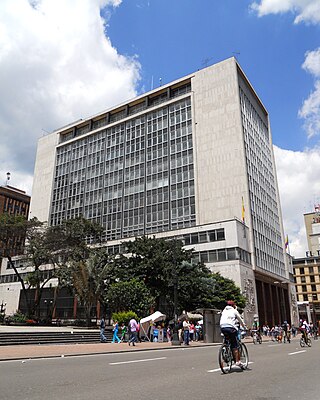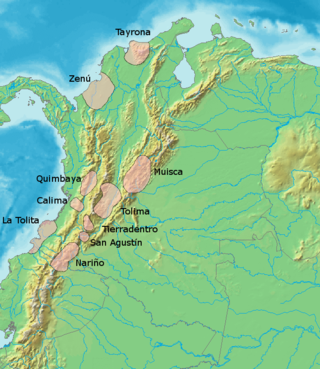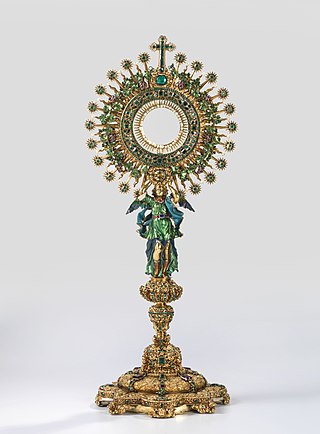
Grave goods, in archaeology and anthropology, are the items buried along with the body.

The Museum of Gold is a museum located in Bogotá, Colombia. It is one of the most visited touristic highlights in the country. The museum receives around 500,000 tourists per year.

Pasca is a town and municipality in the Cundinamarca department of Colombia located in the Andes. It belongs to the Sumapaz Province. Pasca is situated on the Altiplano Cundiboyacense at a distance of 71 kilometres (44 mi) from the capital Bogotá. It borders Fusagasugá, Sibaté and Soacha in the north, Bogotá D.C. in the north and east, Arbeláez in the south and Fusagasugá in the west. Is the entrance to the Páramo del Sumapaz, the biggest ecosystem in its genre in the world. The urban center is located at an altitude of 2,180 metres (7,150 ft) and the altitude ranges from 2,000 metres (6,600 ft) to 3,500 metres (11,500 ft).

Huaca Rajada, also known as Sipán, is a Moche archaeological site in northern Peru in the Lambayeque Valley, that is famous for the tomb of Lord of Sipán, excavated by Walter Alva and his wife Susana Meneses beginning in 1987. The city of Sipán is dated from 50–700 AD, the same time as the Moche Period.

The Varna Necropolis, or Varna Cemetery, is a burial site in the western industrial zone of Varna, internationally considered one of the key archaeological sites in world prehistory. The oldest gold treasure and jewelry in the world, dating from 4,600 BC to 4,200 BC, was discovered at the site. Several prehistoric Bulgarian finds are considered no less old – the golden treasures of Hotnitsa, Durankulak, artifacts from the Kurgan settlement of Yunatsite near Pazardzhik, the golden treasure Sakar, as well as beads and gold jewelry found in the Kurgan settlement of Provadia – Solnitsata. However, Varna gold is most often called the oldest since this treasure is the largest and most diverse.

The Bank of the Republic is the central bank of Colombia. It was initially established under the regeneration era in 1880. Its main modern functions, under the new Colombian constitution were detailed by Congress according to Ley 31 de 1992. One of them is the issuance of the Colombian currency, the peso. The bank is also active in promoting financial inclusion policy and is a leading member of the Alliance for Financial Inclusion.

Poporo is a device used by indigenous cultures in present and pre-Columbian South America for storage of small amounts of lime produced from burnt and crushed sea-shells. It consists of two pieces: the receptacle, and the lid which includes a pin that is used to carry the lime to the mouth while chewing coca leaves. Since the chewing of coca is sacred for the indigenous people, the poporos are also attributed with mystical powers and social status.

The Quimbaya (/kɪmbaɪa/) were a small indigenous group in present-day Colombia noted for their gold work characterized by technical accuracy and detailed designs. The majority of the gold work is made in tumbaga alloy, with 30% copper, which colours the pieces.

Metallurgy in pre-Columbian America is the extraction, purification and alloying of metals and metal crafting by Indigenous peoples of the Americas prior to European contact in the late 15th century. Indigenous Americans have been using native metals from ancient times, with recent finds of gold artifacts in the Andean region dated to 2155–1936 BCE, and North American copper finds dated to approximately 5000 BCE. The metal would have been found in nature without need for smelting, and shaped into the desired form using hot and cold hammering without chemical alteration or alloying. To date "no one has found evidence that points to the use of melting, smelting and casting in prehistoric eastern North America".

The Pre-Columbian Gold Museum is a museum in San José, Costa Rica. It is located in a subterranean building underneath the "Plaza de la Cultura" and is owned and curated by the Banco Central de Costa Rica. The museum has an archaeological collection of 3,567 Pre-Columbian artifacts made up of 1,922 ceramic pieces, 1,586 gold objects, 46 stone objects, 4 jade, and 9 glass or bead objects. The gold collection dates from 300 to 400 BC to 1550 AD. The collection includes animal figurines, amulets, earrings, erotic statuettes and several dioramas including El Guerrero, a life sized gold warrior figure adorned with gold ornaments in a glass case and a detailed scale model of a Pre-Columbian village. There is also a replica of a pre-Columbian grave containing 88 gold objects which was unearthed on a banana plantation in southeastern Costa Rica in the 1950s. In Costa Rican history, gold was considered a symbol of authority and the items are testament to the craftmanship of the Pre-Columbian period.

Calima culture is a series of pre-Columbian cultures from the Valle del Cauca in Colombia.

The Muisca raft, sometimes referred to as the Golden Raft of El Dorado, is a pre-Columbian votive piece created by the Muisca, an indigenous people of Colombia in the Eastern Ranges of the Colombian Andes. The piece probably refers to the gold offering ceremony described in the legend of El Dorado, which occasionally took place at Lake Guatavita. In this ritual, the new chief (zipa), who was aboard a raft and covered with gold dust, tossed gold objects into the lake as offerings to the gods, before immersing himself into the lake. The figure was created between 1295 and 1410 AD by lost-wax casting in an alloy of gold with silver and copper. The raft was part of an offering that was placed in a cave in the municipality of Pasca. Since its discovery in 1969, the Muisca raft has become a national emblem for Colombia and has been depicted on postage stamps. The piece is exhibited at the Gold Museum in Bogotá.

Quimbaya artifacts refers to a range of primarily ceramic and gold objects surviving from the Quimbaya civilisation, which was one of many pre-Colombian cultures of Colombia inhabiting the Middle Cauca River valley and southern Antioquian region of modern day Colombia. The artifacts are believed to have originated during the Classical Quimbaya period 500 BC–600 AD.

La Lechuga is a monstrance made between 1700 and 1707 by José de Galaz for the San Ignacio Church of Bogotá, then part of the New Kingdom of Granada. It was paid for by a group of Jesuits, probably in order to hide the gems contained in it from the Spanish Crown. Currently, La Lechuga is owned by the Bank of the Republic and is on permanent display at the Miguel Urrutia Art Museum in Bogotá, Colombia.

The Muisca Confederation was a loose confederation of different Muisca rulers in the central Andean highlands of present-day Colombia before the Spanish conquest of northern South America. The area, presently called Altiplano Cundiboyacense, comprised the current departments of Boyacá, Cundinamarca and minor parts of Santander.

The Herrera Period is a phase in the history of Colombia. It is part of the Andean preceramic and ceramic, time equivalent of the North American pre-Columbian formative and classic stages and age dated by various archaeologists. The Herrera Period predates the age of the Muisca, who inhabited the Altiplano Cundiboyacense before the Spanish conquest of the Muisca and postdates the prehistory of the region in Colombia. The Herrera Period is usually defined as ranging from 800 BCE to 800 CE, although some scholars date it as early as 1500 BCE.

Marianne Vere Cardale de Schrimpff is a Colombian anthropologist, archaeologist, academic and writer.

This article describes the art produced by the Muisca. The Muisca established one of the four grand civilisations of the pre-Columbian Americas on the Altiplano Cundiboyacense in present-day central Colombia. Their various forms of art have been described in detail and include pottery, textiles, body art, hieroglyphs and rock art. While their architecture was modest compared to the Inca, Aztec and Maya civilisations, the Muisca are best known for their skilled goldworking. The Museo del Oro in the Colombian capital Bogotá houses the biggest collection of golden objects in the world, from various Colombian cultures including the Muisca.

The Calima Gold Museum is an archaeological museum dedicated to the Calima culture located in the historic center of Santiago de Cali, Colombia. The Calima Gold Museum was the ninth museum created by the Bank of the Republic of Colombia in order to show the artistic and cultural expressions of the pre-Hispanic populations. It is also one of the Bank's six gold museums located throughout Colombia, their main one being the Gold Museum in Bogotá.



















